
In this article, I’ll show beginners how to quickly get “up and running” on the guitar and talk about how more advanced “shredders-in-training” can learn to play a guitar fast!
Doing a few simple things and using your time properly can make all the difference in the world! You will begin to see a rapid improvement in your playing and become the guitar player you always wanted to be.
Keep reading to see what I’m talking about and why it will take your guitar skills to the next level.
So, What’s The Secret To Learning Guitar Quickly?

So you’re thinking about getting started on the guitar, or maybe you’ve already given it a go but didn’t get very far.
There’s no secret sauce or magic formula to getting good on the guitar quickly, but there are things you should be focusing on that will significantly improve your playing.
Whether you are learning on your own or taking guitar lessons, incorporate the following ten things into your practice routine, and you’ll be amazed at how rapidly you’ll begin to see results!
If you want to go directly to tips and tricks on shredding guitar, then click here.
Do These 10 Things To Learn Guitar Fast
If you’re a beginner, trying to pick up the basics of guitar quickly, or you want to shred like your favorite guitar hero, the basic process is similar.
Pay close attention to this list of things that are key to guitar skill development, no matter what type of music you play.

Follow A Practice Schedule
It’s essential to create a practice schedule and to stick with it. Set aside time to practice at least 20 to 30 minutes a day. Find a time to practice that offers you the privacy you require to avoid interruptions. Shut off your cell phone, if possible.
Be realistic about choosing your practice material. If you are just beginning, then start by learning how to tune your guitar correctly. Next, familiarize yourself with the basics, like the names of the open strings, the notes going up the neck, and various easy chords.
Tablature (TAB) is a great way to begin learning music without any prior training. There are many places online to get free TAB for thousands of songs. Adding Tab to your schedule will definitely help you learn to play guitar fast.
As you continue to progress on the guitar, break your practice time into skill sections, like rhythm, scales, learning a new piece of music, soloing, ear training, and music theory. Assign various types of skills to different days of the week.
The more organized you are, the quicker you will master the material.
Find The Ideal Practice Time

It’s always a good idea to find a practice time that works for you and try to stick with it. You might be surprised at how this simple idea can boost your productivity.
I met a fellow guitar player back in my college days who told me that the best time to practice is as soon as you wake up in the morning. So he got up every day at 6 AM and played for an hour.
He reasoned that he was “fresh” and that no one was up to bother him at that hour. So I tried it, and all these years later, I still get up at six in the morning to play guitar.
So, find the best time for that magic hour, and you’ll be glad you did!

Don’t “Over-Practice”
It’s best to practice every day for a specified amount of time but stop if you get tired or if things are not going well. Becoming frustrated is counterproductive to making good progress on the material you are trying to learn.
Don’t try to play through arm, wrist, hand, or finger pain. You can develop a medical problem like tendonitis or carpal tunnel syndrome.
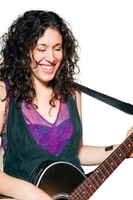
Play What You Like
Learn the music you enjoy playing most. When I first started playing, I took a few guitar lessons, and my teacher had me learning music from a book that I really disliked.
A half-hour of practice seemed like an entire day. I almost quit playing but decided I would learn on my own instead.
I started copying the guitar parts of my favorite tunes off record albums. An hour of practice seemed like 10 minutes, and I started making good progress.
If you enjoy learning in a structured setting, then find a teacher that is a good fit for the music you want to play, or you can enroll in an online guitar program like Yousician, Fender Play, or Truefire.
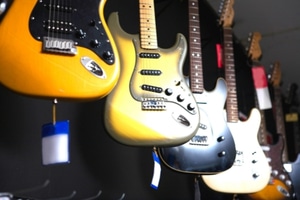
Find The Right Guitar
Finding the right guitar can make all the difference in your learning experience, especially when you are first starting. Beginners often get frustrated with a guitar that is difficult or even painful to play and begin to lose interest.
Guitars that have thick gauge strings or strings that are too high off the surface of the neck are more difficult to press down enough to produce a clear sounding note and can make your fingers uncomfortably sore until you begin to form calluses.
Electric guitars are usually easier to set up to be more “player-friendly” for beginners than acoustic guitars. You can always start on a cheap electric guitar and then switch to an acoustic instrument when you become a better player.
For more info, see Fingertips Hurt Playing Guitar? – How To Stop The Pain!

Develop Good Playing Habits
Developing good playing habits is key to taking your playing to the next level. Proper playing posture should be comfortable but put your arms and hands in the best position over your guitar and at the right angle.
The best positioning will depend on if you are playing while sitting or standing and on the type of guitar you have. If you plan on performing for an audience, then practice your entire song list sitting and standing. People that only play while sitting may find it very difficult to play standing and vice-versa.
If you play standing, don’t forget to adjust your guitar strap to place your guitar at a height that makes it easiest to play. This can vary, depending on your body height, arm length, and playing mechanics. Experiment with different guitar heights and see what works best for you.
Playing mechanics are also very important and will help you improve quickly. Proper placement of both arms and hands is critical to getting the best sound, speed, accuracy, and precision.
Mastery of picking mechanics and learning the ideal hand position on the guitar neck for playing chords and single-note lines complement each other and will allow you to perform effortlessly all over the neck.
Learn to reduce or eliminate string noise from your playing, like squeaks and buzzes. For more info, see Reduce Guitar String Noise – Make Every Note Sound Awesome!
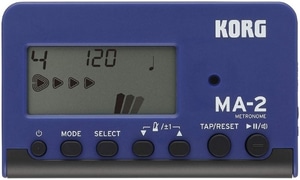
Learn How To Keep Time
Learning how to lock in on the tempo of the music or “keep time” is crucial to making good progress on the guitar and becoming a great player.
A metronome will get you on track with this in no time. However, if you can’t afford a metronome, learn to keep time by tapping your foot. Foot tapping is an excellent way to keep time with the music because this is a metronome that is always available, even when playing in live situations.
Watch a few music videos, and you’ll begin to notice that some of the most extraordinary players, like Al Di Meola and Eric Clapton, tap their foot while playing on-stage. It looks natural and keeps you playing in time with the rest of the band.
I began using a metronome after playing for a few years, after discovering that my playing was out of time and a little sloppy, especially when I played fast or complicated guitar solos. A metronome helped me fix this in no time!
The sooner you begin using a metronome, the more beneficial it will be. Buy a digital metronome, or you can use a free one online.

Learn Something New Each Day
Try to learn one new thing every day. It can be something as simple as a single guitar lick, or you can make up a melody or chord progression.
Spend 10 or 15 minutes at the end of each practice session having fun learning something new, or you can do it as a break from a tedious piece of music halfway through.
You’ll be amazed at how much you have learned after a month of adding this little exercise as part of your daily routine!

Teach What You Learn
One of the best ways to solidify what you learn is to teach it to another guitar player! Teaching can really make you put a concept together in your mind and find new applications for the information.
I’ve taught quite a few students over the years, and it has helped me organize my musical skills and allowed me to identify and fill multiple gaps in my own playing.
There’s nothing better than the feeling of accomplishment and satisfaction you get from helping someone else grasp a difficult concept.
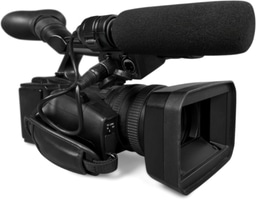
Record Yourself
Listening to a recording of what you play is one of the best ways to identify your mistakes and opportunities for improvement.
An audio recording will help you find things like problems with timing or note clarity. A video recording can help you spot problems with your right or left-hand technique.
Recording yourself can be a rewarding experience by comparing it to older recordings and hearing or seeing how much you have improved.
Get in the habit of recording yourself often. It’s a good idea to play your recordings for other guitarists who are willing to give your their input on your performance. They will often spot things you may have missed.

The Best Way To Learn Shred Guitar
Here are some tips on how to play guitar fast, in the “shred-style.”
If you want to shred guitar like Yngwie Malmsteen, Joe Satriani, or Steve Vai, start by learning the basics of playing scales, arpeggios, and chords.
Chords are important because they help you choose the appropriate scales and arpeggios to play over what’s happening in the rhythm part of the song. Learning music theory is a great way to understand the relationship between how melody and harmony work together.
Learning the “CAGED” system will give you the ability to visualize chords, scales, and arpeggios all over the guitar neck.

Think Slow To Play Fast
Always remember to slow everything down while you are learning it! It can seem a little counter-intuitive, but the best way to learn to play something fast is to practice it slow!
Maybe you can already play fast, but not all your notes sound clear and on time, especially if you use distortion or echo. The easiest way to remedy this is to make a metronome your best friend.
Start as slow as it takes to play the passage on time, clearly, and with even dynamics. Then, begin to increase the tempo on the metronome “little by little” until you can play it up to speed and without mistakes.

Keep It Melodic
Great shred guitar is more than running scales or arpeggios up and down the neck, no matter how fast you can play them. If you play this way, your solo can sound more like a practice session than a performance piece.
To add interest to a shred-style solo remember to keep it melodic by playing around the notes of the song’s lyrics. If the song is purely instrumental then establish a recurring melodic motif at the beginning and base your solo around that.
Get Some Help From Your Amp
To help you learn to play hammer-ons, pull-offs, and legato phrases get an amplifier that has enough gain to sustain the notes you play. You don’t have to spend a lot of money on an amp. You can buy a high-gain micro-amp or a low-wattage combo amp.
For a great 1-Watt, all-tube amp, see Marshall DSL1C Review – This Little Amp Will Surprise You!
Use The Right Pick
Find the pick that works best for you. I like to use a pick with a sharp point and a non-slip finish. It’s essential to keep the pick from slipping between your thumb and index fingers or dropping it during high-speed passages.
See The Five Best Guitar Picks For Grip, With Buyer’s Guide! for more info.

Frequently Asked Questions
Here are some of the most common questions that I’m asked about learning to play the guitar.
How Fast Can I Teach Myself Guitar?
This depends on what material you practice, how much effort you put in, and how quickly you learn. You can usually learn the basics in 2 to 4 months. However, learning all there is to know about playing the guitar is a lifetime pursuit.
How Many Hours A Day Should I Practice Guitar?
When you are first starting, play for 15 to 20 minutes a day and slowly work your way up to 1 hour. If you want to practice 2 or 3 hours a day, then break it up into sections, like 1 hour in the morning, noon, and evening.
Take 1 or 2 breaks during a 1-hour session. If you begin to feel discomfort in your arms, wrists, hands, or fingers, stop immediately.

Take A Break
Is It Bad To Practice Guitar Too Much?
Every guitar player has an ideal practice time, somewhere between not enough and too much. It’s important to know when to stop. There is a “point of diminishing returns,” after which you will make very little if any progress on the guitar.
Never make practicing the guitar a struggle or something you dread doing. Instead, make learning and improving your skills fun by keeping your practice sessions manageable and targeted to your actual skill level.
What Age Is Too Late To Learn Guitar?
You are never too old to learn how to play the guitar, assuming your health permits it! Everyone at any age can find something they enjoy from what the guitar has to offer.
Learning to play the guitar is a great activity to begin in your retirement years when you have more time to pursue new interests. I have seen people start playing in their 80s and do exceptionally well.
Guitar playing can be a great form of music therapy at any age, but especially in the elderly.
For more info, see Learning Guitar For Seniors – Make Each Day Great With Music.

Which Guitar Is Best For Beginners?
I usually recommend beginning on an electric guitar, which tends to be easier to learn on than an acoustic guitar.
You don’t have to spend a lot of money on your first guitar. If you purchase an electric instrument, then have it set up with light-gauge strings and low action.
You don’t necessarily need an amplifier to begin playing on an electric guitar. You can still learn all the basics and then add an amp later on.
Acoustic guitars can also take light-gauge strings, but they tend to be farther away from the frets, which can make them more difficult to press down properly when you are first learning.
What’s The best Way To Learn Guitar For Free?

There are several approaches to learning how to play the guitar without paying for lessons.
If you have a good musical ear, you can copy songs from audio CDs, record albums, or MP3 files.
There are many excellent instructional books that you can buy or borrow at the library.
If you don’t mind using a computer to learn, there are an almost unlimited number of instructional blogs and guitar videos on every subject.
Here is a video from Marty Music that shows you how to use a device that can slow down and loop YouTube videos. Check it out!
There are also many excellent online instructional apps for guitar. Yousician offers a free account with limited play-time that will definitely get you started.
What’s The Fastest Way To Learn Guitar Chords?
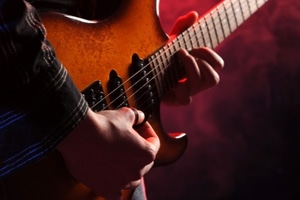
Start with the standard “open chords,” which are played on open and fretted strings in the first 3 to 4 frets.
If you want to get more sophisticated, you can learn the “moveable (barre) chords” that can be played up the neck without using a capo.
Buying a good guitar chord book that you can use for a reference is a great way to make quick progress.
There are also many great free instructional videos on how to play chords and chord progressions.
What’s The Fastest Way To Learn Guitar Scales?
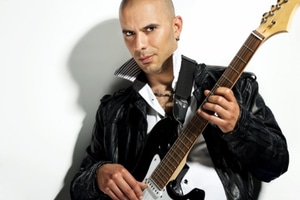
Start by choosing the scales that best fit the type of music you play.
If you play rock or blues, then begin by learning the minor pentatonic and blues scale. Shredders typically favor the harmonic minor scale. If you like country music, then try using the major pentatonic scale. Finally, jazz and classical players prefer using the seven diatonic modes.
Don’t try to learn too many scales at once. It’s easy to get overwhelmed with all the information, and it will just slow you down. Instead, begin with one scale and learn to play it all over the guitar neck.
What’s The Fastest Way To Learn Fingerpicking?
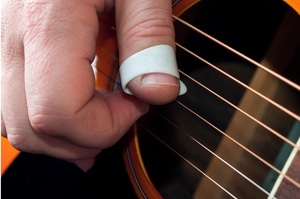
Begin by using your thumb and three adjacent fingers. Start slowly with simple picking patterns. Aim for accuracy, note clarity, and even dynamics. Gradually increase your picking up to tempo.
After you master the basics, you can move to more complex picking patterns and using thumb and finger picks.
There are various good fingerpicking books and online resources that can help you learn the concepts quickly.

Final Thoughts On Learn To Play A Guitar Fast
Learning to play the guitar fast, like anything worth doing, is a process. Reaching your desired skill level requires an organized practice schedule and commitment. However, knowing the right approach and applying it to what works best for you can dramatically improve the process.
To keep yourself motivated and your practice sessions enjoyable, focus on the type of music you want to play. However, be realistic about what you are trying to accomplish and the time and dedication it will require to achieve it.
Start with a guitar that is ideally suited for your skill level and playing style. A guitar that is too difficult to learn on can slow your progress down significantly, especially if you are a beginner. For more info, see How To Fix Guitar String Problems – Easy Things You Can Do!
If you are a beginner, start by learning to tune your guitar correctly. Next, learn the names of the notes on each open string and up the neck. Finally, learn how to play basic chords and melodic patterns. It’s ok to try to learn quickly but don’t rush or skip essential skills.
As you gain more confidence in your playing, you can begin to tackle more complex concepts.
More advanced players that are trying to play faster or “shred guitar” should be focused on starting slow and gradually increasing the tempo of a difficult scale or solo until it can be played up to speed with precision, accuracy, and clarity. The best way to do this is by using a metronome.

Choose The Way You Learn Best And Make It Happen
Choose the way you learn best and a plan that fits into your budget. Paid methods will usually allow you to make quicker progress, but there are many excellent free alternatives. It’s ok to mix and match learning methods, such as taking in-person lessons and independent study online but be sure to stick to a practice schedule to keep you adequately focused.
Never let playing with gadgets like effects boxes for an electric guitar or recording studio equipment take away from your core practice time. Instead, add additional time during the day to experiment with things that are fun but do not improve your skill level.
You are never too young or too old to begin playing the guitar or any other instrument. So if you are thinking about starting to play music, now is the time to “take the plunge.” Use the tips and tricks in this article to get yourself started with quick improvement.
What To Read Next ➡ Conquering The Fretboard: Ultimate Guide To Finger Speed!
Related Article ➡ Is Playing A Guitar A Talent Or Skill? – Secrets To Success!
Tell Me What You Think

Would you mind letting me know what’s on your mind in the comment section or if I can help you with anything?
- Are you currently trying to improve your guitar skills? If so, what things have you found most helpful?
- Do you use online tools or educational resources to help you learn to play the guitar fast? Which ones?
- If you are thinking about playing the guitar has this article convinced you to give it a try?




Loved the article! I cannot stress enough how important the tips you mentioned are. It goes without saying that these tips are not only for the guitar, these are things that everybody should follow whether they are practicing instruments or not. The tips you mentioned help avoiding burnouts and boredom that is the most frequent issue I see in other musicians. This was a really fun read. Kudos to you and thanks!
Hi, Al
I appreciate your comments.
Glad you found the article helpful. It’s essential to take an organized and systematic approach to learn things that require a lot of dedication and effort.
Frank
Hi Frank. Thank you for very interesting article. I just started my adventure with electric guitar and I must admit its not so easy as I thought at the beginning. Yet your post is very helpful and some points are really eye openers. I never thought about recording myself but it seems as a great idea to spot and correct mistakes I made. Looking forward to use your advices in practice.
Hi, Cogito
Thank You for your comments!
It takes a bit of practice and patience to start to see some real progress on the guitar, but trust me; it’s worth it! Just keep on playing and make sure to have some fun in the process. It’s easy to get bogged down with all kinds of technical stuff, so start with the basics and take it slow.
It’s a good idea to record everything you play and then take a positive approach when you review it. Nobody is perfect, so don’t let your mistakes bother you. The more you play, the better you’ll get.
Frank